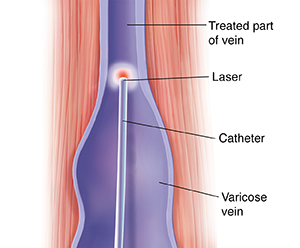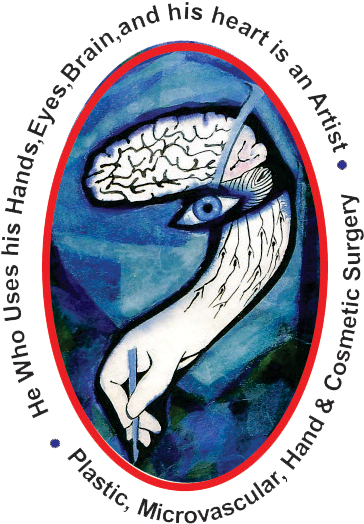Endovenous Laser Treatment
Endovenous laser treatment (EVLT) is a procedure that uses laser heat to treat varicose veins.
Varicose veins are swollen and enlarged veins. They occur most often in the legs. Varicose veins can develop when valves in your veins become damaged. This causes problems with blood flow. Over time, too much blood collects in the veins. The veins may bulge, twist, and stand out under your skin. They can also cause symptoms such as aching, cramping, or swelling in your legs.
During EVLT, heat created using a laser is sent into the vein through a thin, flexible tube (catheter). This closes off blood flow in the main problem vein.

Getting ready for your treatment
Follow any instructions from your healthcare provider.
Tell your healthcare provider if you:
- Are pregnant or think you could be
- Are breastfeeding
- Smoke or use alcohol on a regular basis
- Have other health problems, such as diabetes or kidney problems
Tell your provider about any medicines you are taking. You may need to stop taking all or some of these before the procedure. This includes:
- Medicines that can thin your blood or prevent clotting (anticoagulants)
- All prescription medicines
- Over-the-counter medicines such as aspirin or ibuprofen
- Street drugs
- Herbs, vitamins, and other supplements
Follow any directions you’re given for not eating or drinking before the treatment.
The day of your treatment
The treatment takes 45 to 60 minutes. The entire treatment (including time to prepare and recover) takes about 1 to 3 hours. You can go home the same day. For the treatment:
- You’ll lie down on a hospital bed.
- An imaging method, such as ultrasound, is used to guide the procedure.
- The leg to be treated is injected with numbing medicine.
- Once your leg is numb, a needle makes a small hole (puncture) in the vein to be treated.
- The catheter containing the laser heat source is inserted into your vein.
- More numbing medicine may be injected around the vein.
- Once the catheter is in the right position, it’s then slowly drawn backward. As the catheter sends out heat, the vein is closed off.
- In some cases, other side branch varicose veins may be removed or tied off through several small cuts (incisions).
- When the treatment is done, the catheter is removed. Pressure is applied to the insertion site to stop any bleeding. An elastic compression stocking or a bandage may then be put on your leg.
Questions? We got Answers!
Your veins pump blood from the heart throughout other areas of your body. The process completes itself as this blood is pumped back to the heart again. In order for the circulation of blood flow to reach extremities, such as your legs and feet, the muscles must contract and valves within the veins must open, allowing the blood to pass. In the case of people with varicose veins, these valves fail to work properly, causing the blood to pool in spots.
This can result in venous diseases such as varicose veins or spider veins, a milder and common variation. Varicose veins are typically large and dark purple or blue in color, often appearing right below the skin’s surface, while spider veins tend to be smaller and may appear as red, blue, or purple. You may notice either of these issues seem to appear suddenly, and unfortunately tend to increase over time. While they may be painless at first, varicose veins can eventually cause the following symptoms:
- Aching, pain, and heaviness in the legs and feet;
- Burning, throbbing, cramping, or swelling in the affected areas;
- Pain that worsens after sitting or standing for long periods;
- Hardening of the veins and skin ulcers, which indicate a more serious form of vascular disease, one that requires immediate medical attention.
If you are experiencing any of the above symptoms, our staff and board certified Interventional Radiologists at Advanced Vein Therapy may be able to help. You may be a candidate for endovenous laser ablation treatment, a common, safe, and highly effective minimally-invasive procedure.
Endovenous laser treatment (EVLT) is a minimally invasive procedure that can provide patients with relatively fast and highly effective relief from the painful symptoms and unsightly appearance of varicose veins.
At Advanced Vein Therapy, we can schedule you an initial consultation with our physicians to review your medical history and the symptoms you are currently experiencing. We can then discuss your diagnosis, the potential health ramifications, and all of the treatment options that may be available in your particular situation. Once you and your doctor decide on EVLT as the best course of action, we will create a customized treatment plan and set a date to schedule the procedure.
On the day of your treatment, our staff will warmly greet you and escort you to the procedure room, while helping you relax and answering any last-minute questions or concerns you have. At this point, they will also begin preparing your leg for the treatment. The following information explains exactly how EVLT works and what to expect on the day of the procedure:
- An ultrasound will be performed, with the radiologist marking the veins that will be treated;
- Your leg will be thoroughly cleaned to prevent the risk of infection at the treatment site and covered with surgical draping;
- Depending on where the unhealthy vein is located, you may be resting comfortably on your front or back side;
- Prior to treatment, you will be given a local anesthetic to alleviate any possible discomfort you may experience;
- During the procedure, the doctor will insert a thin fiber into the unhealthy vein;
- Once the laser is turned on, you will not feel pain but you may hear a buzzing sound and experience a slight burning smell or taste in your mouth;
- As the laser fiber emits a wave of light over the vein, it eventually closes and is absorbed into the body’s tissue.
The entire procedure generally takes between 60 to 90 minutes per leg. Once the varicose vein is closed, the blood will eventually reroute to another, healthier vein.
After completing endovenous laser treatment, the results patients experience can vary. In some cases, varicose veins disappear completely during the recovery period. In other situations and in more severe cases, it may take up to a year for the unhealthy vein to no longer be visible. Most people are likely to fall somewhere in the middle of these timeframes. The following highlights what to expect post-treatment:
- In the immediate aftermath of endovenous laser ablation surgery, you will be wrapped in an ace bandage and your compression sock. This helps to reduce swelling and potential blood clots.
- You may have some bruising and discomfort, which should diminish over a period of two weeks.
- While rest is an important part of the healing process, you will be encouraged to get up and move around frequently during your recovery
- Be aware that, depending on the number of veins that require treatment, your doctor may need to schedule your procedure over several appointments. During this time, avoid any strenuous activities and again, closely follow all of the instructions you are provided with.
It is important for patients with varicose veins and other venous diseases to realize that there is no permanent solution to this type of problem and that the issue may reappear again at some point in time. However, in terms of long-range results, endovenous laser ablation treatment is credited with having an excellent recovery rate.
The National Institutes of Health (NIH) reports that EVLT is among the most successful of treatments. In addition to the obvious advantages of using state-of-the-art lasers rather than more invasive surgical techniques, studies show that over a five-year period following treatment, EVLT is also proven to be highly effective in preventing a recurrence of varicose veins.

